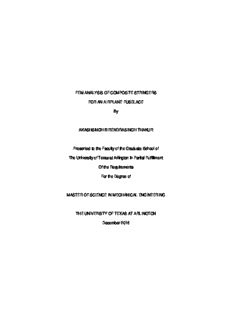
FEM ANALYSIS OF COMPOSITE STRINGERS FOR AN AIRPLANE FUSELAGE By AKASHSINGH PDF
Preview FEM ANALYSIS OF COMPOSITE STRINGERS FOR AN AIRPLANE FUSELAGE By AKASHSINGH
FEM ANALYSIS OF COMPOSITE STRINGERS FOR AN AIRPLANE FUSELAGE By AKASHSINGH BIRENDRASINGH THAKUR Presented to the Faculty of the Graduate School of The University of Texas at Arlington in Partial Fulfillment Of the Requirements For the Degree of MASTER OF SCIENCE IN MECHANICAL ENGINEERING THE UNIVERSITY OF TEXAS AT ARLINGTON December 2016 Copyright © by Akashsingh Birendrasingh Thakur 2016 All Rights Reserved ii Acknowledgements I would like to express my gratitude towards Dr. Andrey Beyle for guiding and helping me throughout my thesis research. He always had time to discuss my work and helped solve any problems that I faced during my research work. I would like to thank Dr. Wen Chan and Dr. Kent Lawrence for finding time out of their busy schedule to serve on my thesis defense committee. I am indebted to my colleagues and friends for being there whenever I needed any help or support. I would especially like to thank my lab mates Himanshu Raut, Gopal Gulwani, Aditya Dandekar for their continued support throughout my research. Lastly, I would like to thank my family. I would especially like to thank my father, Birendrasingh Thakur, my mother Babita Thakur and my younger brother Ashishsingh Thakur for their support all these years. It was their continued support and belief that I have been able to do all that I have done so far. I would also like to offer my regards to all those who have supported or helped me in any regards through this period. iii Abstract FEM ANALYSIS OF COMPOSITE STRINGERS FOR AN AIRPLANE FUSELAGE Akashsingh B Thakur, MS The University of Texas at Arlington, 2016 Supervising Professor: Andrey Beyle With the advent of technology, materials have advanced many folds; One such technical revelation has been Fiber-reinforced Composite Materials. Composite materials have two major advantages, among many others: Improved strength and stiffness, especially compared to other materials on a unit weight basis. For example, Composite materials have stiffness comparable to the stiffness of steel but with a strength decimal order higher and more than three times lighter. These advantages have led to new aircraft and spacecraft designs that are radical departures from past efforts based on conventional materials. The stringers serve to take up(along with the skin) the compression and tension forces created at the bending of the fuselage, besides the stringers with frames strengthen the skin, thus increasing its critical compression and shearing stress. This paper focusses on a comparative study of Aluminum Alloys and Composite materials for a Stringer. Composite materials such as Glass Fiber reinforced composite, Kevlar Epoxy and Carbon fiber reinforced composite are used for the study. Stringers with various cross-sections such as I-beam, box beam and double I-beam are analyzed for composite materials, along with those made up of Aluminum alloys for the same boundary conditions. It is observed that compared to Aluminum 6061-T6, iv composites show lower displacement in Carbon and Kevlar, whereas lower stresses in all for the same boundary and loading conditions. v Table of Contents Acknowledgements .............................................................................................................iii Abstract .......................................................................................................................... iv List of Illustrations ............................................................................................................. viii List of Tables ....................................................................................................................... x Chapter 1 ............................................................................................................................ 1 1.1 What are Stringers? .................................................................................................. 1 1.2 Research Objectives ................................................................................................ 3 1.3 Composites ............................................................................................................... 4 Chapter 2 ............................................................................................................................ 7 Geometry ............................................................................................................................ 7 Chapter 3 .......................................................................................................................... 13 Chapter 4 .......................................................................................................................... 16 4.1 Bending ................................................................................................................... 16 4.2 Torsion .................................................................................................................... 17 4.3 Buckling .................................................................................................................. 18 Chapter 5 .......................................................................................................................... 19 5.1 Aluminum 6061-T6 ................................................................................................. 19 5.2 Glass Fiber ............................................................................................................. 20 5.3 Kevlar ...................................................................................................................... 20 5.3 Carbon Fiber ........................................................................................................... 21 5.4 Epoxy Resin ............................................................................................................ 22 Chapter 6 .......................................................................................................................... 40 Simulations ................................................................................................................... 40 Chapter 7 .......................................................................................................................... 43 vi Results .............................................................................................................................. 43 7.1 Deformation: ........................................................................................................... 43 7.2 Stresses: ................................................................................................................. 44 7.3 Torsional Results: ................................................................................................... 45 7.4 Buckling Results: .................................................................................................... 46 7.5 Deformation and Stress Result Tables: .................................................................. 46 7.6 Deformation and Stress Result Graphs: ................................................................. 47 Chapter 8 .......................................................................................................................... 51 Conclusion ........................................................................................................................ 51 References ........................................................................................................................ 53 Biographical Information ................................................................................................... 55 vii List of Illustrations Figure 1-1 Stringer-frame assembly. .................................................................................. 2 Figure 1-2 Stringer cross-sections ...................................................................................... 3 Figure 0-3 Fiber Classification............................................................................................5 Figure 2-1 I beam cross-section………………………………………………………………...7 Figure 2-2 I beam geometry……………………………………………………………………..8 Figure 2-3 Box cross-section…………………………………………………………………….8 Figure 2-4 Box geometry…………………………………………………………………………9 Figure 2-5 Double I cross-section……………………………………………………………….9 Figure 2-6 Double I geometry………………………………………………………………….10 Figure 3-1 Cantilever……………………………………………………………………………13 Figure 3-2 6 DOF………………………………………………………………………………..14 Figure 3-3 Clamped……………………………………………………………………………..15 Figure 5-1 Glass Fiber………………………………………………………………………….21 Figure 5-2 Kevlar Fiber…………………………………………………………………………22 Figure 5-3 Carbon Fiber………………………………………………………………………..23 Figure 6-1 Box Beam 45 degrees layup……………………………………………………...41 Figure 6-2 Lay-up direction…………………………………………………………………….41 Figure 6-3 I beam Lay-up direction……………………………………………………………42 Figure 7-1 Deformation in Aluminum I-beam 6 DOF………………………………………..43 Figure 7-2 Stresses in Carbon-Epoxy box beam cantilever………………………………..44 Figure 7-3 Stresses in Glass Laminates I-beam clamped………………………………….44 Figure 7-4 Torsion in Aluminum Cantilever case……………………………………………45 Figure 7-5 Buckling....................................................................................................…...46 Figure 7-6 Deformation in I-beam……………………………………………………………..48 viii Figure 7-7 Stresses in I-beam………………………………………………………………….48 Figure 7-8 Deformation in box beam (Cantilever)……………………………………………49 Figure 7-9 Deformation in box beam (Clamped)…………………………………………….49 Figure 7-10 stresses in box beam……………………………………………………………..50 Figure 7-11 Deformation in Double I beam…………………………………………………..50 Figure 7-12 Stresses in Double I beam……………………………………………………….51 Figure 7-13 Weight difference of beams…………………………………………………...…52 ix List of Tables Table 2-1 Section properties for I-beam………………………………………………………11 Table 2-2 Section properties for box beam…………………………………………………..12 Table 5-1 Fiber and Matrix Properties………………………………………………………...21 Table 5-2 combined fiber matrix properties…………………………………………………..39 Table 7-1 Results of torsional analysis………………………………………………………..45 Table 7-2 Load multipliers……………………………………………………………………...46 Table 7-3 I beam Deformation and Stresses…………………………………………………47 Table 7-4 Box beam Deformation and Stresses……………………………………………..48 Table 7-5 Double I beam Deformation and Stresses………………………………………..48 Table 7-6 Weight difference……………………………………………………………………51 Table 8-1 Material Ranking…………………………………………………………………….53 x
Description: